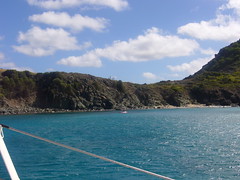Ten years ago, besides fretting about and spending millions of dollars to head off the impending Y2K computer meltdowns, there was some real concern about how we were to describe the coming decade. There were a variety of suggestions that just did not seem right. We had the Double-Os, the Y2Ks, the Zeroes, the Noughties, the Singles, the 2000s, the Millies, and my favorite, the Oh-Ohs.
Well, decades tend to name themselves. Now after 10 years we know Wired Magazine got it right. Even though the Noughties seems to have traction, I submit we say good-bye this evening to the Naughties.
Yes, there is only one letter difference and it does take care not to pronounce the two words the same. But I would prefer to remember the decade's sweet-as-sin naughties rather than the zeros who were in charge of our economy, politics, and war-machine most of the time. (They know who they are.)
I am not hearing much discussion about 2010-2019. I suppose these could be the Twenty-Somethings, but it will probably be the Teens again. OK by me. I am perfectly content to be a Teenager again. With what I learned in the Naughties, this should be like totally F-word awesome.
Thursday, December 31, 2009
Saturday, December 19, 2009
Summer, 1971
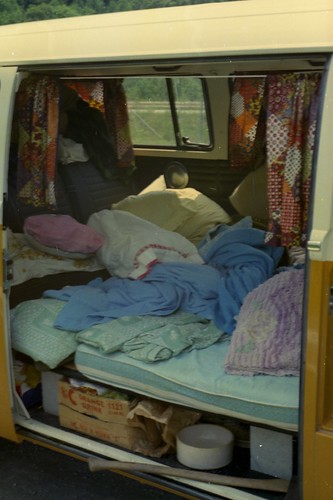
In response to absolutely no request at all from the previous post, here is a photo of the interior of that 1971 VW bus during the Summer of '71. Like a champ it took 6 adults (mostly) and a wonderful German Shepherd camping from Virginia to California and BACK in about 4 weeks. Burned only one valve - that bad boy #3 exhaust - driving I-70 up the Rocky Mountains west of Denver. All this with less than 60 hp.
Notice the curtains:)
Wednesday, December 16, 2009
Hippies Welcome!
 So, I was driving out of Charlotte yesterday having made a major dent in my Christmas shopping when my eye caught this sign in a VW dealer's window. It was so good I turned around and took this photo. Cute you think, Hippies Welcome, but worth turning around on busy Independence Avenue? There must be a story, you think.......correctly.
So, I was driving out of Charlotte yesterday having made a major dent in my Christmas shopping when my eye caught this sign in a VW dealer's window. It was so good I turned around and took this photo. Cute you think, Hippies Welcome, but worth turning around on busy Independence Avenue? There must be a story, you think.......correctly.It was late spring 1971 and I wanted a VW bus, wanted one bad. So one Saturday afternoon I walked into the VW dealer in Danville, Virginia and saw a yellow and white bus on the showroom floor. No salesman was in sight, the place was empty. So I walked around until I found a guy sitting at a desk. I asked if the Bus on the floor was for sale; he said yes. I told him I would take it and I asked him to get some final sales numbers together so I could go to the bank and get a check. He just stared. Finally something snapped, and he went into car salesman mode. He said he would be happy to get a sales price for me. In about 15 minutes I was on my way back to Mecklenburg County, paperwork in hand. I had not even opened the door to my new car.
Midweek I called him, told him I had the check, and would be back on Saturday to settle up with him. He seemed a bit surprised. Yes, he said, they would have it ready.

Saturday my wife and I drove to pick up the bus. After signing all the papers I asked if he would mind riding with us around town a bit, I had never driven a VW before. That gave him more pause. Sure, he said, sounding a bit uncertain.
You must remember this was 1971 and my wife and I probably looked a awful lot like those hippies he had heard about. So he rode shotgun and I slipped behind the wheel for a quick tour of Danville. He alternated between pointing out the vehicle's features, and just... looking at us. Finally he asked, "You aren't going to paint flowers on the side, are you?" My wife and I had long since picked up on his vibes, and I suppose we could have had some fun at his expense. But we didn't. Trying to maintain a straight face we almost said in unison, "Oh no, we wouldn't do anything like that." He relaxed a bit. Then it could have been me, but I think it was my wife who said softly, "Curtains might be nice."
We dropped him off and I kept that bus for almost 25 years. Sure, the last 10 or so I didn't drive it much, but I just could not let it go. Great memories, wonderful memories.
So, ex-wife? True story, or what?
And no, the picture above is not THE bus, but it is a dead ringer. Stole it off the internet. I fear most of the photos I do have of that particular bus could be used as evidence.
So here is to Volkswagen of America and times that change.
Or not. During the 5 minutes or so I was on the premises no salesman approached me. Not after I made a big production of taking a picture of the front of their building. Not after I walked about looking at the new cars. Maybe I need to get a haircut.
Wednesday, November 25, 2009
Chesapeake Studies
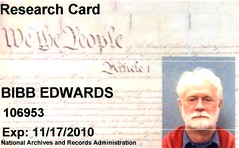 Looking for all the world like a homeless refugee from the chilly Washington streets I wandered into the U.S. National Archives last Tuesday, was IDed multiple times, and thus began another week of research on the road. In search of more information for my book project, my visit to D.C. yielded nothing except the knowledge that if what I was seeking existed, it was not in the National Archives. That and this card, good for a year.
Looking for all the world like a homeless refugee from the chilly Washington streets I wandered into the U.S. National Archives last Tuesday, was IDed multiple times, and thus began another week of research on the road. In search of more information for my book project, my visit to D.C. yielded nothing except the knowledge that if what I was seeking existed, it was not in the National Archives. That and this card, good for a year.Fleeing the afternoon D.C. traffic I then took refuge at Gunston Hall, home of George Mason, one of our least known of the Founding Fathers. It was quite tranquil; save the occasional aircraft sounds, it was probably more quiet than in Mason's day when it would have been a busy household with children about, farm animals being tended, and slaves preparing for the end another plantation day. I was the only visitor by 4 o'clock, so I had what amounted to a private tour. The interior of the house does not reflect the relative modest exterior. If you are ever south of D.C. on highway 1, or nearby on I-95, it is worth a detour. You might enjoy it more than nearby Mount Vernon, which will certainly be more crowded.
The next day took me to the Northern Neck. First was to the awful subdivision that is what became of my mother's homeplace to assist in resolving a property line question. Then I visited the Northumberland County Historical Society to purchase a back issue of their Bulletin. Lunch found me across the Rappahannock at Lowery's for lunch, a tradition. Crab cakes. As the afternoon waned I was heading into the Western Shore of Maryland and the Holiday Inn at Solomons Island. It was there I was to spend the next three days attending a conference, The Early Chesapeake: Refections and Projections.
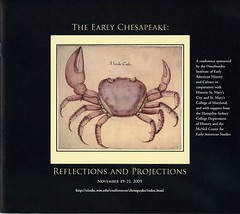 For me it was like attending an induction ceremony at the Rock & Roll Hall of Fame, or the Champions Dinner at the Masters. Present were the pioneers of Chesapeake Studies, presenters of often ground-breaking papers, and the authors of many of the books on my bookshelves. In addition I was able to take guided tours of the Jefferson Patterson Park & State Museum of Archaeology, Historic St. Mary’s City and St. Mary’s College of Maryland. But what I will remember most were the conference goers I met and chatted with, and the ideas we exchanged. While this was a conference of mainly academic and otherwise professional historians and archaeologists, many made me feel as if I belonged. It was a timely, well-run, and well-attended conference. Thanks to the Omohundro Institute of Early American History and Culture.
For me it was like attending an induction ceremony at the Rock & Roll Hall of Fame, or the Champions Dinner at the Masters. Present were the pioneers of Chesapeake Studies, presenters of often ground-breaking papers, and the authors of many of the books on my bookshelves. In addition I was able to take guided tours of the Jefferson Patterson Park & State Museum of Archaeology, Historic St. Mary’s City and St. Mary’s College of Maryland. But what I will remember most were the conference goers I met and chatted with, and the ideas we exchanged. While this was a conference of mainly academic and otherwise professional historians and archaeologists, many made me feel as if I belonged. It was a timely, well-run, and well-attended conference. Thanks to the Omohundro Institute of Early American History and Culture.Sunday morning I drove down the neck of land that forms the Western Shore to Point Lookout, the Maryland side where the Potomac empties into the Bay. This sliver of land is among my oldest memories; it is directly across the water from my grandmother's house on the Northern Neck. I had never been there. On my trek north to the highway 301 bridge back to Virginia I stopped at St. Mary's City where I yet again played historical tourist. Finally, as the weather was turning colder and clouds were moving in, I returned to my car for the uneventful seven-hour drive home.
As I have spent most of November on the road, I am glad to be stationary for a while. Though tomorrow we will be in Charlotte for Thanksgiving at my daughter's, and Saturday we are hosting a dinner for other friends and family - including about a dozen Chinese scholars from UNC-P - I now need to consolidate my thoughts and research; I need to write.
Saturday, November 14, 2009
Smoketown USA
Yesterday I returned from an almost two-week road trip, 2895 miles worth. It was close-to-perfect, the planned and the unexpected. Even the weather was great. It was a multi-purpose excursion centered around attending the 75th Annual Meeting of The Southern Historical Association in Louisville and doing some research for the book I am working on. But I used the trip to also visit with some friends of long standing, some I had not seen in decades. Visiting with them is what made this trip so very special to me.
So here is a big Thank You to Layla, Gregg, Leslie, Kyle and Ellis, Burt, Ellen, Barbara and Alison, and Phil and Rebecca. Also my thanks to the staff at the Frontier Culture Museum, The Filson Historical Society, Cave Hill Cemetery, Historic Old Louisville, the Third Avenue Cafe, Cahokia Mounds State Historical Site, the Kentucky Historical Society, and the numerous Starbucks who provided the caffeine.
Almost getting lost in my narrative is the SHA Annual Meeting. I attended first class, fascinating sessions with topics as diverse as School Desegregation in Norfork, 1960's British Blues, and Thomas Jefferson's favorite slave family, the Hemings. My goal was to meet and hang out for a few days with real historians, and to learn something. Mission accomplished. I am already looking forward to their meeting in Charlotte next year.
A more complete reminisce of the past two weeks would include harvest happy mid-western farmers, microfilm follies, and not one, but two landslide closed Tennessee roads that made for an interesting Friday. (I knew about the first, but not the second.) But I will spare you all the details. I really don't have the time as I am preparing for another road trip next week, this time to a place I have always wanted to visit in Maryland, and another gathering of historians.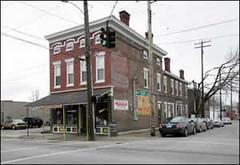
I will close with a promise fulfilled. A bright, happy volunteer named Mary I was chatting up at the Old Louisville Visitors Center asked if I liked Bar-B-Q. Before I could answer the expression on my face made her reach for a brochure. Wonderful food, nice people, "You must eat there before you leave," she said. So Gregg and I did just before I left The Real West Virginia (a.k.a Kentucky). Folks, it was as she said. Best Ribs I have ever had, best greens too. I told the owner I would blog about the food and the friendly people. So I have. Go to Louisville. Go to Smoketown USA. Order the ribs.
So here is a big Thank You to Layla, Gregg, Leslie, Kyle and Ellis, Burt, Ellen, Barbara and Alison, and Phil and Rebecca. Also my thanks to the staff at the Frontier Culture Museum, The Filson Historical Society, Cave Hill Cemetery, Historic Old Louisville, the Third Avenue Cafe, Cahokia Mounds State Historical Site, the Kentucky Historical Society, and the numerous Starbucks who provided the caffeine.
Almost getting lost in my narrative is the SHA Annual Meeting. I attended first class, fascinating sessions with topics as diverse as School Desegregation in Norfork, 1960's British Blues, and Thomas Jefferson's favorite slave family, the Hemings. My goal was to meet and hang out for a few days with real historians, and to learn something. Mission accomplished. I am already looking forward to their meeting in Charlotte next year.
A more complete reminisce of the past two weeks would include harvest happy mid-western farmers, microfilm follies, and not one, but two landslide closed Tennessee roads that made for an interesting Friday. (I knew about the first, but not the second.) But I will spare you all the details. I really don't have the time as I am preparing for another road trip next week, this time to a place I have always wanted to visit in Maryland, and another gathering of historians.

I will close with a promise fulfilled. A bright, happy volunteer named Mary I was chatting up at the Old Louisville Visitors Center asked if I liked Bar-B-Q. Before I could answer the expression on my face made her reach for a brochure. Wonderful food, nice people, "You must eat there before you leave," she said. So Gregg and I did just before I left The Real West Virginia (a.k.a Kentucky). Folks, it was as she said. Best Ribs I have ever had, best greens too. I told the owner I would blog about the food and the friendly people. So I have. Go to Louisville. Go to Smoketown USA. Order the ribs.
Sunday, October 18, 2009
Rickie Lee Jones, Part Two
 Saturday night was the second time I had seen Rickie Lee Jones. The first was November 14, '03 at the Barrymore in Madison when she was touring in support of The Evening of My Best Day. She has been long a favorite of mine with her inventive jazz-flavored arraignments, close-to-the-bone non-commercial lyrics, smart-ass yet sensitive personae, and that voice. That voice with a style that cannot be emulated, the most musical instrument in the mix. That night I discovered another Rickie Lee Jones, band leader. Then into middle age - she was 49 - past the years when she could dazzle an audience with just her youthful smile, she took the stage in blue jeans and what I remember as a flannel shirt. (Maybe it was just November in Wisconsin.) Her stage, her band, her music. She was in charge, demanding you listen and think about her lyrics, giving you no choice but to sync with the rhythms of 1970's and 80’s L.A. She soon had the audience in the palm of her hand; I could not look away. By the end of that night I think we were all breathing in unison. Last night, in front of a smaller, much different audience, fronting a smaller band less sure of itself, supporting the coming release of another album, Balm in Gilead, Rickie Lee Jones proved she is still in charge, that her music still will never be found in the easy-listening bin, and that voice is as strong and clear as ever.
Saturday night was the second time I had seen Rickie Lee Jones. The first was November 14, '03 at the Barrymore in Madison when she was touring in support of The Evening of My Best Day. She has been long a favorite of mine with her inventive jazz-flavored arraignments, close-to-the-bone non-commercial lyrics, smart-ass yet sensitive personae, and that voice. That voice with a style that cannot be emulated, the most musical instrument in the mix. That night I discovered another Rickie Lee Jones, band leader. Then into middle age - she was 49 - past the years when she could dazzle an audience with just her youthful smile, she took the stage in blue jeans and what I remember as a flannel shirt. (Maybe it was just November in Wisconsin.) Her stage, her band, her music. She was in charge, demanding you listen and think about her lyrics, giving you no choice but to sync with the rhythms of 1970's and 80’s L.A. She soon had the audience in the palm of her hand; I could not look away. By the end of that night I think we were all breathing in unison. Last night, in front of a smaller, much different audience, fronting a smaller band less sure of itself, supporting the coming release of another album, Balm in Gilead, Rickie Lee Jones proved she is still in charge, that her music still will never be found in the easy-listening bin, and that voice is as strong and clear as ever.The Carolina Theater was her first performance in 16 months, the first show of a tour what will carry her into the northeast, to Europe, back to Carnegie Hall, and home to California by the Christmas holidays. Her material was a mix of old and new, with a wonderful continuity that made it difficult to distinguish between the two. Her band was clearly still in the process of mastering the arrangements. When it all came together, she beamed. When it did not, her frustration was obvious. At the end of one song she commented with a bit of a forced smile that, since it was a song from her upcoming album, we had no idea how much they had just "fucked.....it......up."
Nonpareil bassist Rob Wasserman was to her right through it all - watching her hands like a hawk - providing a solid bottom end, rhythm, and grace notes. The remaining band members, two young keyboard players, were clearly in-process. Rickie Lee’s music is not simple. There are no flashy drums, electronica, or simple heavy bass lines to use as a crutch. When it works it is magical; when it does not - like much in life - it discomforts.
Rickie Lee’s recorded music is honest and heartfelt, sometimes painfully so. To get something out of it one must put something in. She is the same in person, no bullshit. She is not for everyone; she does not try to be. She reminded me again last night how much I appreciate that.
Tuesday, September 22, 2009
Grace Potter and the Nocturnals
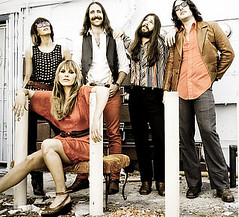 In 1958 Danny and the Juniors' Rock and Roll Is Here To Stay topped out at #19 on the Billboard chart. The song was written more in hope than certainty. From its beginnings a few years earlier, when it was decried from pulpits and denounced in city halls as corrupting America's (white) youth, rock and roll has had powerful enemies. As that decade ended it all seemed over. Elvis had been drafted, Jerry Lee Lewis was blacklisted, Little Richard had become "born again," Buddy Holly was dead in a plane crash, Chuck Berry had been railroaded to jail, and Alan Freed and Dick Clark had been tainted by payola scandals. Already faced with the prospect of integrating their public schools, many saw rock and roll - young whites singing and dancing to black music - as further subverting the social order. The large national record companies, which had been been caught unprepared for the demand for this new type of music by white teenagers, sought to reestablish their marketplace dominance by promoting "wholesome" cover versions of songs by popular black artists. (Think Pat Boone doing Little Richard's Tutti Fruti. Awful then; awful now.) In rural Virginia, connected to the rest of the world by two-lane blacktops, the glowing tubes of radio and TV, and Life magazine, I was taking all of this in. I had just become a teenager; rock and roll was our music, my music.
In 1958 Danny and the Juniors' Rock and Roll Is Here To Stay topped out at #19 on the Billboard chart. The song was written more in hope than certainty. From its beginnings a few years earlier, when it was decried from pulpits and denounced in city halls as corrupting America's (white) youth, rock and roll has had powerful enemies. As that decade ended it all seemed over. Elvis had been drafted, Jerry Lee Lewis was blacklisted, Little Richard had become "born again," Buddy Holly was dead in a plane crash, Chuck Berry had been railroaded to jail, and Alan Freed and Dick Clark had been tainted by payola scandals. Already faced with the prospect of integrating their public schools, many saw rock and roll - young whites singing and dancing to black music - as further subverting the social order. The large national record companies, which had been been caught unprepared for the demand for this new type of music by white teenagers, sought to reestablish their marketplace dominance by promoting "wholesome" cover versions of songs by popular black artists. (Think Pat Boone doing Little Richard's Tutti Fruti. Awful then; awful now.) In rural Virginia, connected to the rest of the world by two-lane blacktops, the glowing tubes of radio and TV, and Life magazine, I was taking all of this in. I had just become a teenager; rock and roll was our music, my music.I bought my first record, Fats Domino's Blueberry Hill - a 78 no less - two years earlier. I had seen Elvis in prime time and watched American Bandstand in the afternoons. I listened to after-school music shows on local AM radio, and, when I could get away with it, late night rock and roll from exotic Buffalo, Chicago, Fort Wayne, New Orleans, and Memphis. I had no idea what thrills awaited someone up on Blueberry Hill, but I damn well wanted to find out.
Of course, as we know now in the fullness of time, rock and roll didn't die. But it certainly suffered abuse. It has survived splintering into dozens of sub-genres, being co-opting in advertisements, The Cover of the Rolling Stone, big corporate money, drugs, MTV, synthesizers, a respectable Hall of Fame, artist deaths, the rise and fall of FM radio, and file sharing. It suffered disco, karaoke, hair bands, amusical punks, makeup, Auto-Tune, stadium rock and automated oldies stations. Occasionally it seems to have survived time itself by becoming embraced by some in later generations even as we boomers often seemed reluctant to share.
Still, since 1974 when Jon Landau famously proclaimed Bruce Springsteen as the future of Rock and Roll - a title Mr. Springsteen continues to wear with grace - I have often despaired for that most revolutionary of evolutionary music that formed the soundtrack of my life. Is there anybody out there that still cares?
Fast forward to this summer. I am sitting in the wing of a stage in the mountains of Virginia at an outdoor music festival. My grown, mother-to-be daughter sits beside me. We are waiting for a band I have never heard to close out the evening's music. A power outage has caused a delay of almost two hours. It has been a long day, I am looking forward to crawling into my sleeping bag. The seat in the folding chair is hard. The lights come up, the band is announced: Grace Potter and the Nocturnals.
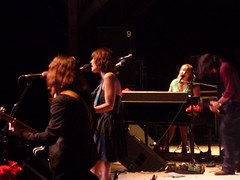 Two in the band who take the stage are impossibly young women; so which one is Grace? One picks up a tambourine and heads to the microphone laying down a rhythm. She counts off. The other young woman starts a bass riff as the drummer doubles the tambourine. Grace wails like a Celtic warrior, "Oh Yeah." A guitar chords an opening and we are off on Some Kind of Ride. Suddenly the hard seat is forgotten. I am not tired. I am getting goosebumps. Time has vanished. Who are these guys?
Two in the band who take the stage are impossibly young women; so which one is Grace? One picks up a tambourine and heads to the microphone laying down a rhythm. She counts off. The other young woman starts a bass riff as the drummer doubles the tambourine. Grace wails like a Celtic warrior, "Oh Yeah." A guitar chords an opening and we are off on Some Kind of Ride. Suddenly the hard seat is forgotten. I am not tired. I am getting goosebumps. Time has vanished. Who are these guys?Since Floydfest I have downloaded all the GPN albums and several live audience recordings. I have watched her on YouTube. Here are my observations...
- Grace Potter is a musician. Sure, she has a powerful, nuanced voice. But there are many accomplished voices out there, with or without Auto-Tune. (Auto-Tune is to music as steroids are to baseball.) Grace sings with no need for electronic enhancement; loud or soft, she sells the lyric. Grace closes her Falling or Flying with, "play every show as if it's your last." That is how she sings, as if every line will be her last, every syllable her final defining take. I have yet to hear any recording where she seems to be mailing in a performance. Grace also plays both the Hammond B3, electric pianos, and guitar on stage. But most importantly - like the great ones - she writes her own songs, songs filled with thought and crafted with care. I find it hard to believe they come from the mind and heart of one in her mid 20's. Finally, she respects our music, honors the genre. I like that.
- The Nocturnals are not just a bunch of sidemen. Even though they recently changed bass players and added a second guitar, they are tight, cohesive, and well matched with each other. The second guitar adds depth and allows Scott Tournet space to stretch out. He has a good ear, avoids rock cliches and sounds fresh. The rhythm section is driving, solid. The occasional addition of Catherine Popper's voice to the mix makes a much more polished sound. One can be clever and describe GPN as a neoclassicial rock and roll band. If that means timeless, OK by me.
- I don't think any GPN records yet do full justice to the band, especially with its current lineup. I hope their forthcoming disc does. Until then, hear them live if you can. Fortunately they are a touring band, coast to coast. The will be in Wilmington, NC next month at a smallish outdoor venue, promoted by some nice folks at Greater Good Productions. I already have tickets.
- GPN have paid their dues and earned the respect of their peers and the press. Try here, here, or here. That I had not heard of them reflected on me more than them. Given the fractured, unsettled nature of the music business these days I don't know what constitutes the path to stardom or success. But if quality, commitment, and joy count - Grace Potter and the Nocturnals are already on the charts, with a bullet. Rock and roll is in good, young hands.
I don't know if Grace Potter and the Nocturnals are the future of rock and roll. But if the music has a future it will be someone like Ms. Potter who keeps it alive.
Friday, August 21, 2009
WSJ Woodstock Rant - Revisited
The August 14th, 2009 edition of the WSJ was kind enough to reprint an editorial it published almost 40 years ago about that summer's Woodstock Festival. As I did not read it then - I was not into the Journal - I found it a fascinating reminder of those polarizing days, those days when "Which side are you on?" was becoming serious business. It would get worse.
What strikes me after all these years is the obvious anger this autonomous editorial writer feels. Nowhere does he mention - in those days it certainly would not have been a she - the Vietnam war, the civil-rights movement, women's liberation, the environment movement (the first Earth Day would be the following spring), or the growing sense among many young people that there was more to life than obedience to authority and the individual accumulation of wealth. But I am sure these were in the back of his mind as he turned looking for "Three Days of Peace and Music" into "opting for physical, intellectual and cultural squalor."
The Wall Street Journal is still published by and for authority, whether political or economic - and presumably after 40 years maybe by some of us who grew out of the "it" below. Oddly their two-page remembrance contained little mention of the capitalist roots of the festival. It was a money-making enterprise gone wrong. The first blow was struck a month before the festival was to open when the town government where the festival was planned effectively banned it. The lesson from this would be right up the WSJ's alley, never trust the government.
The festival promoters were not able to find an alternate site and construct the facilities in time to receive the second blow, many more thousands and thousands of young people than the site could well accommodate. The WSJ lesson would be to spend more money on market research.
So it became a "free festival," and depending on who one talked to, either a disaster area or a peaceful first gathering of the tribe. Then, finally, it rained. I am not sure how the WSJ handles bad weather even today. They probably are against it.
I had first considered annotating the editorial below with clever, amusing comments developed in the fullness of time. However I decided to let the oddly bitter words of the author speak for themselves. We of the Woodstock Nation still love him anyway, and would give him a big hug and pass him a joint if he wanted a hit. Peace brother.
I will only note sadly that the spirit of this editorial writer still haunts the offices of the WSJ. Try reading their current smug, myopic, and disingenuous opinions that suck up to the powers of our day and age. Personally I still refuse to read anything on their editorial pages.
By Squalor Possessed
Wall Street Journal, Aug 28, 1969
What strikes me after all these years is the obvious anger this autonomous editorial writer feels. Nowhere does he mention - in those days it certainly would not have been a she - the Vietnam war, the civil-rights movement, women's liberation, the environment movement (the first Earth Day would be the following spring), or the growing sense among many young people that there was more to life than obedience to authority and the individual accumulation of wealth. But I am sure these were in the back of his mind as he turned looking for "Three Days of Peace and Music" into "opting for physical, intellectual and cultural squalor."
The Wall Street Journal is still published by and for authority, whether political or economic - and presumably after 40 years maybe by some of us who grew out of the "it" below. Oddly their two-page remembrance contained little mention of the capitalist roots of the festival. It was a money-making enterprise gone wrong. The first blow was struck a month before the festival was to open when the town government where the festival was planned effectively banned it. The lesson from this would be right up the WSJ's alley, never trust the government.
The festival promoters were not able to find an alternate site and construct the facilities in time to receive the second blow, many more thousands and thousands of young people than the site could well accommodate. The WSJ lesson would be to spend more money on market research.
So it became a "free festival," and depending on who one talked to, either a disaster area or a peaceful first gathering of the tribe. Then, finally, it rained. I am not sure how the WSJ handles bad weather even today. They probably are against it.
I had first considered annotating the editorial below with clever, amusing comments developed in the fullness of time. However I decided to let the oddly bitter words of the author speak for themselves. We of the Woodstock Nation still love him anyway, and would give him a big hug and pass him a joint if he wanted a hit. Peace brother.
I will only note sadly that the spirit of this editorial writer still haunts the offices of the WSJ. Try reading their current smug, myopic, and disingenuous opinions that suck up to the powers of our day and age. Personally I still refuse to read anything on their editorial pages.
By Squalor Possessed
Wall Street Journal, Aug 28, 1969
The so-called generation gap is not really so much a matter of age as it is a gap between more civilized and less civilized tastes. As such, it may be more serious, both culturally and politically, than it first appeared.Starting with the relatively small hippie movement several years ago, the drug-sex-rock-squalor “culture” now permeates colleges and high schools. When 300,000 or 400,000 young people, most apparently from middle-class homes, can gather at a single rock festival in New York State, it is plainly a phenomenon of considerable size and significance.
We would not want to exaggerate. Probably a goodly number will grow out of it, in the old-fashioned phrase. On campus, the anti-radicals seem to be gaining strength, and it may well be that these more conservative youngsters will be the people who will be moving America in the future.
But that prospect is by no means certain enough to encourage complacency. For various reasons it is being suggested that many rebels will not abandon their “life-styles” (the cliches in this field! ) and that there are enough of them to assume some of the levers of power in the future American society. It would be a curious America if the unwashed, more or less permanently stoned on pot or LSD, were running very many things. Even if the trend merely continues among young people in the years ahead, it will be at best a culturally poorer America and maybe a politically degenerated America.
Now taste is that amorphous quality about which one is not supposed to dispute, so we won’t argue whether rock is a debased form of music; we don’t like it, but never mind. Without pursuing that argument, it is possible, we think, to say a couple of things quite categorically about rock and related manifestations.
One is that a preference for a particular kind of music is not necessarily a matter of age. In times past many young people were drawn to classical music and retained that taste as they grew older. Today the young’s addiction to rock is at the same time a rejection of classical and the more subdued types of popular music, and considering the way rock is presented it must be counted a step down on culture’s ladder.
That is our second point: The orgiastic presentation on the part of some of the best-known groups. It is not prudish, we take it, to suggest that a certain amount of restraint is appropriate in these matters. But then, the whole “life-style” of many of the performers is incredible—disgusting or pitiful or both, but certainly hoggish.
The same applies to public sex in the audience, also in evidence at the mammoth Woodstock festival. It is not necessary to be a Puritan to say that such displays are regressive from the point of view of civilization. As for the ubiquitous drugs—well, we guess on that score we feel more sorry for the kids than anything else.
What perhaps gets us most is the infatuation with squalor, the slovenly clothes and the dirt; at Woodstock they were literally wallowing in mud. How anybody of any age can want that passes our understanding. Again, though, it’s not a question of age. A person doesn’t have to be young to be a hobo. He does, however, have to have certain tastes and values (or non-tastes and non-values) which are not generally regarded as being of a civilizing nature.
Now we are aware of all the cant about how these young people are rejecting traditional tastes and values because society has bitterly disappointed them, and we would be the last to deny the faults in contemporary society. It is nonetheless true that their anarchic approach holds no hope at all.
They won’t listen, but if they, and some of the unduly sympathetic adults around, would listen, here are some words worth bearing. They occur in a speech by Professor Lawrence Lee to a social fraternity at the University of Pittsburgh, quoted in National Review:
“You have been told, and you have come to believe, that you are the brightest of generations . . . You are, rather, one of the most self-centered, self-pitying, confused generations . . . .
“The generation gap is one of the delusions of your generation—and to some men of my generation. . . . The only generation gap is that we have lived longer, we know more than you do from having lived, and we are so far ahead of you that it will take you a lifetime to have the same relative knowledge and wisdom. You had better learn from us while you can. . . .
“It is not mawkish to love one’s country. The country, with all of its agony and all of its faults, is still the most generous and the most open society on the earth. . . . All generations need the help of all others. Ours is asking yours to be men rather than children, before some frightened tyrant with the aid of other frightened and ignorant men seeks to make all of us slaves in reaction to your irresponsibility.”
In any event, opting for physical, intellectual and cultural squalor seems an odd way to advance civilization.
Monday, August 03, 2009
FloydFest 8 - Revival
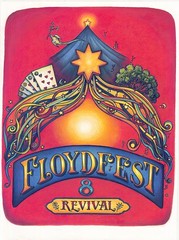 July 23rd through 26th I attended my fifth consecutive Floydfest. All have been different; all have left me with wonderful memories. By now I know enough to expect the unexpected. One would think that mindset would have prepared me for this year. It didn't.
July 23rd through 26th I attended my fifth consecutive Floydfest. All have been different; all have left me with wonderful memories. By now I know enough to expect the unexpected. One would think that mindset would have prepared me for this year. It didn't.First, instead of attending with several carloads of relatives, this year it looked like it would just be Anita and me. Then, about a month before, Anita badly damaged a big toe. I will spare you the details and photos. As Floydfest approached it became evident she would not be able to go. We had hoped Anita's niece, husband and daughter Rachel (A former Best Camper) would be able to take the tickets. They bowed out the weekend before the festival was to start. With not enough time to to sell the two (rather expensive) tickets, I decided to go by myself. I then offered my daughter the other ticket. A few months pregnant and having not been feeling all that chipper, she had decided weeks ago not to attend. But she reconsidered mid-week and told me she would meet me on site Friday evening. So Thursday morning early I pointed Buster, Anita's old truck, north.
I had decided before I left that I was going to try camping in the woods this year to avoid the sun-baked heat of field camping.
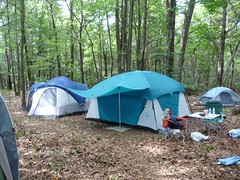
But by the time I arrived, about four hours after the gates opened, many of the best sites were taken. Undeterred, I found a spot and managed - with some passerby help - to get the tent in place and the camp established. This photo makes the site look flat. It was not. Still the trees did provided shade and it was very convenient to the music, food, and porta-potties. I then wandered about in search of the music.
My first surprise was the Jesse Chong Band from Virginia Beach at the Hill Hollar stage as the sun was going down.
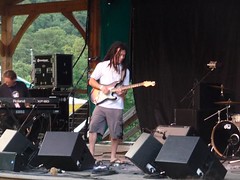 They were just smoking. Sure, the guy could play and his band was tight, but what impressed me were the arraignments. There was always something interesting going on with the beat, the rhythm. Here is a sample on YouTube. His website also has videos. None really do justice.
They were just smoking. Sure, the guy could play and his band was tight, but what impressed me were the arraignments. There was always something interesting going on with the beat, the rhythm. Here is a sample on YouTube. His website also has videos. None really do justice.The next day I happened by the Garden Stage and caught the last part of the set by Samantha Crain and the Midnight Shivers.
 If someone can kick some serious musical butt sweetly, it is Samantha. I took the photo to the right the next day when she played the Hill Hollar. Difficult to categorize, Samantha's music has an edge that belies her demeanor and the familiar forms her music takes. Her website has videos also.
If someone can kick some serious musical butt sweetly, it is Samantha. I took the photo to the right the next day when she played the Hill Hollar. Difficult to categorize, Samantha's music has an edge that belies her demeanor and the familiar forms her music takes. Her website has videos also.After Malindi arrived and was settled in we walked about as the sun was setting in search of more music. Then Floydfest went dark, quickly, mostly. Actually a fuse blew on a power line off-site and for about two hours the festival was operating on a few backup generators and batteries.
So what happened with thousands of festival goers and seven stages? Simple; the musicians played and sung acoustically, and the audiences mellowed around them. Read about it here.
While walking back towards the Main Stage we stopped by the Children's Universe where we heard the Barcelona Institute of Gospel.
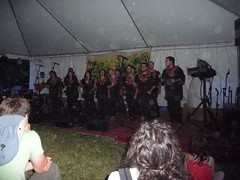 They were singing in the dark without their microphones everything from Proud Mary to Billie Jean, J.S. Bach to a song from the Lion King. The arraignments to bring the young singers from Spain to the U.S. had been made by a Floyd County Virginia Tech student, details here. Malindi and I sat in awe. Someone had a video camera and posted part of their performance on YouTube. As we walked away I felt as if nothing could top that. I was (again) wrong.
They were singing in the dark without their microphones everything from Proud Mary to Billie Jean, J.S. Bach to a song from the Lion King. The arraignments to bring the young singers from Spain to the U.S. had been made by a Floyd County Virginia Tech student, details here. Malindi and I sat in awe. Someone had a video camera and posted part of their performance on YouTube. As we walked away I felt as if nothing could top that. I was (again) wrong.I had heard that Friday night's closing Main Stage band, Grace Potter and the Nocturnals, was pretty good.
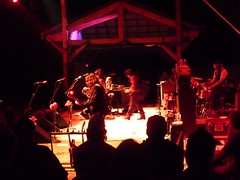 As the festival electricians were patching together enough emergency power so the band could take the stage and we were taking our seats on the side stage (a benefit of those expensive tickets) the local power company restored power to the site. Late, but now with full power, the show would go on. When Grace and her band hit the stage it was as if one had shaken up a hot two-liter coke bottle and then ripped off the cap. I had seen and heard bands on that huge stage for four previous festivals. I had never questioned if the stage was large enough, until Grace Potter. Friends and neighbors, they almost took the roof of that sucker. She sounds like a combination of Janis and Bonnie Raitt, with all their energy but with a better feel than either for a ballad. Her band could have been playing full tilt at Woodstock or almost any venue since. Timeless rock and roll. Playing mostly originals with a few covers that they well honor, Grace Potter and the Nocturnals just get it. It may be too late to catch them in a small club again, but catch them if you can. Mp3s of that performance can be found at archive.org. It is worth the download. I was awestruck, again.
As the festival electricians were patching together enough emergency power so the band could take the stage and we were taking our seats on the side stage (a benefit of those expensive tickets) the local power company restored power to the site. Late, but now with full power, the show would go on. When Grace and her band hit the stage it was as if one had shaken up a hot two-liter coke bottle and then ripped off the cap. I had seen and heard bands on that huge stage for four previous festivals. I had never questioned if the stage was large enough, until Grace Potter. Friends and neighbors, they almost took the roof of that sucker. She sounds like a combination of Janis and Bonnie Raitt, with all their energy but with a better feel than either for a ballad. Her band could have been playing full tilt at Woodstock or almost any venue since. Timeless rock and roll. Playing mostly originals with a few covers that they well honor, Grace Potter and the Nocturnals just get it. It may be too late to catch them in a small club again, but catch them if you can. Mp3s of that performance can be found at archive.org. It is worth the download. I was awestruck, again.It proved difficult to top Friday night. But for about 25 minutes Saturday afternoon...
I had first heard Donna The Buffalo at Floydfest 4.
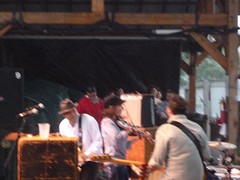 More or less joining their Herd, I had probably listened to them a dozen times since. But Saturday was special. As they took the Main Stage at 5 dark clouds rolled in. By the second song the wind was blowing a hard rain across the stage soaking us all. Donna played on. It got worse. Donna played on. The rain rendered Tara's violin bow useless and she wisely left the stage looking like she was fleeing an unvoluntary wet-T-shirt contest. Her band mates played on. Equipment started to fail. The band played on; the audience kept dancing. When I realized they were not going to stop I set my camera on video mode and captured a few minutes. Those videos became my first YouTube posts - here and here. Electrical power outages? Wind and rain? Not a problem at Floydfest.
More or less joining their Herd, I had probably listened to them a dozen times since. But Saturday was special. As they took the Main Stage at 5 dark clouds rolled in. By the second song the wind was blowing a hard rain across the stage soaking us all. Donna played on. It got worse. Donna played on. The rain rendered Tara's violin bow useless and she wisely left the stage looking like she was fleeing an unvoluntary wet-T-shirt contest. Her band mates played on. Equipment started to fail. The band played on; the audience kept dancing. When I realized they were not going to stop I set my camera on video mode and captured a few minutes. Those videos became my first YouTube posts - here and here. Electrical power outages? Wind and rain? Not a problem at Floydfest.Of Saturday night, no comment. Blues Traveler brought additional gate receipts, but that was about all. As my mother always reminded me, "If you can't say something nice...."
 Sunday morning at 10 found me in the Pink Floyd Garden Stage for a short set by local (Blacksburg) singer/songwriter Kat Mills. She is a Floydfest regular and so I hope she remains. Motel Blues, Saturday; what a wonderful way to start the day. After she finished I made my way to the Virginia Folklife Workshop Porch to wait for Peter Rowan.
Sunday morning at 10 found me in the Pink Floyd Garden Stage for a short set by local (Blacksburg) singer/songwriter Kat Mills. She is a Floydfest regular and so I hope she remains. Motel Blues, Saturday; what a wonderful way to start the day. After she finished I made my way to the Virginia Folklife Workshop Porch to wait for Peter Rowan.Rowan is a legend, with a wide and deep musical heritage that defies categorization. Born in Boston, he formed a Tex-Mex band in high school. He played with Bill Monroe in the mid-196o's.
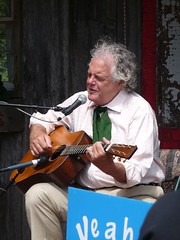 He then joined David Grisman in a folk-rock band, Earth Opera. He played in the rock-fusion band Seatrain in the early 1970's and then recorded a one-shot album with Grisman, Vassar Clements, Jerry Garcia, and John Kahn, Old and In the Way. According to Rowan's website it remains the biggest selling bluegrass album of all time. His song from that album, Panama Red, recorded later by a Garcia side project, the New Riders of the Purple Sage, is iconic.
He then joined David Grisman in a folk-rock band, Earth Opera. He played in the rock-fusion band Seatrain in the early 1970's and then recorded a one-shot album with Grisman, Vassar Clements, Jerry Garcia, and John Kahn, Old and In the Way. According to Rowan's website it remains the biggest selling bluegrass album of all time. His song from that album, Panama Red, recorded later by a Garcia side project, the New Riders of the Purple Sage, is iconic.Since the seventies, Rowan has traveled widely, playing almost every kind of music imaginable - and a few beyond - including reggaebilly. But he always seems to come back to front porch music and bluegrass. And on Floydfest's small Workshop Porch Rowan parked himself Sunday morning, sang several songs, told some stories, and then played a short set with his bluegrass band prior to taking the larger Hill Hollar stage at 1:30.
 Later Rowan joined Railroad Earth on that stage for a version of the mountain standard, the Cuckoo.
Later Rowan joined Railroad Earth on that stage for a version of the mountain standard, the Cuckoo.Railroad Earth closed out the festival, playing until past 6 pm. I have written so much about them over the years anything more seems unnecessary. They have remained a Floydfest staple, bringing their very American eclectic music to a very eclectic American gathering. Sufficient to write that they played well and it was great the see the guys again. We have tickets to see them again next month in Charlotte.
There were dozens of wonderful performers at Floydfest I have failed to highlight: The Emmit-Nershi Band, The Duhks, Grupo Fantasma, Nathan and the Zydeco Cha-Chas, Olabelle, Adrienne Young and Old Faithful, Doug and Telisha Williams, William Walter & Co., The Dynamites featuring Charles Walker, the Lee Boys. And then there was Spiral. All deserve space on someone's blog, just not mine this time around.
I could also mention the wonderful food the folks from Chicago served behind the main stage. I could highlight the helpful volunteers who made us all feel so welcome. The vendors who add so much were out in full force this year. I could mention the couple who dreamed up Floydfest and then made it happen. Maybe next year.
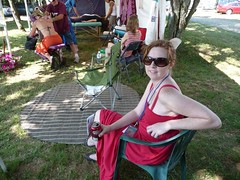
Best Camper this year goes to my daughter, despite her needing to find a port every 30 minutes. It was a special treat to once again share Floydfest with her. Like Grace Potter and her Nocturnals, Malindi gets it. Driving rain and power outages, rank potties and two bands you want to hear scheduled at the same !#@**! time, all are just ingredients in the gumbo. All are a part of that experience of becoming just a bit more alive than usual, of being with thousands of friends you just haven't met yet, of being for one long week-end a year in that Virginia state of grace, Floydfest.
Wednesday, April 08, 2009
It was 20 years ago today...Part Three
On my fifth day the clamp was completely closed. A couple of hours later I began to get a headache, a VERY bad headache, very different from the ones caused by the aneurysm. In fact, it was different from any headache I had ever experienced. It seem to have no center, my whole head hurt. My eyes became very sensitive to light, small sounds were way too loud. I had trouble concentrating, thinking clearly. (Yes, worst than normal.) I had never had a migraine, but my symptoms sounded like one. My brain was now operating on 3 out of 4 carotid arteries; it did not like the new normal.
The doctors and nurses did what they could. Pain meds seemed to have no effect. I asked for a cool, damp towel to cover my head, curled up in the darkened room, and rode it out.
After about 48 hours - it seemed longer - the pain subsided. The tube was removed from the Silverstone clamp and the remaining small hole closed. I was moved out of the ICU to a regular room; they were preparing me to go home. I remember the hot shower the nurses finally let me take - with care to keep water off the neck - as being one of the most wonderful physical experiences of my life.
It was agreed that the operation was a success, that I would probably have more headaches, and I should go home, take it easy, and in two months come back for another angiogram to see if the procedure had the desired effect. What was unstated were the consequences if it did not.
A friend came to W-S and drove me home in my car. After 10 days in the hospital, despite being very well attended to, I was happy to leave. I was surprised that the ride home left me so tired. I walked directly through my front door, took a right into my bedroom and did not rise for several hours. I had become exhausted from sitting upright in the car for an hour and a half. It was less the aneurysm and operation than lying on my back for 10 days.
About a week after my discharge I drove to Asheville to the Mountain Area Health Education Center (MAHEC). I looked and felt better than I had in the hospital, but not by much. I asked for books about aneurysms. After a couple of hours I left, my head spinning, not by a headache but by what I had read. I now knew how deadly and debilitating aneurysms were. I read the texts, saw the photos, absorbed the statistics. And while I realized how lucky I had been so far, I knew I could still drop dead any moment. Another long ride home.
The migraine-like headaches returned. They were never as bad as the initial one, but usually bad enough to render me useless for a while. If possible I would just crawl into a bed and try to sleep through them. At first they came on about three times a week and would last for 12 to 18 hours. Fortunately, they began slowly, giving plenty of warning for me to adapt. As the weeks, months, and years went by they decreased in frequency, duration, and intensity. It took about five years for them to disappear completely. Otherwise I was great. My stamina returned, the incision became a light scar that neatly hid among the other lines on my neck. Other than the nagging thought that I could keel over at any moment and die without anything that could be done, I was just great.
I went back to work. My medical insurance covered just about everything. My vision, which had changed enough for me to need new glasses, returned to “normal.” I took that to mean the grape-sized aneurysm was getting smaller. I tried to imagine it becoming a raisin. I also tried to figure if there was anything triggering my headaches, to no end. After an episode after meal at a Chinese restaurant I became convinced that MSG was the key. It was not. I tried not to dwell on how one small section of artery, maybe an inch or so in length, could render an otherwise healthy person null and void. Here I was in the prime of my life and I could be taken down by a short length of bad tubing. How annoying, as the British would say. I finally tried to think about how fortunate I had been so far, how nice it was to be...anywhere.
I did not know what to expect when I checked back into the hospital in late March. That I was still alive was a good sign. Yet until the results from the angiogram were known I still had no prognoses. Once again they rolled me into that large room with all the equipment and staff. This time when I came to I was in the hallway and a technician I had not seen before was trying to get my attention. He had sheets of x-ray film in his hand. Through the fog I saw him point at the outline of a skull and heard him say, “It worked, Mr. Edwards.” He kept repeating, “It worked!” He sounded very happy, maybe surprised.
That evening in my room I had the TV on and was paying minimal attention to some cable medical show. At one point they had a gurney rolling down a hospital corridor, the camera showing what it looked like from the patient’s point of view. That caught my attention just long enough to watch the gurney roll through a set of doors and into a room that looked a lot like that large room with all the equipment and staff I had seen that morning. I turned up the sound and started paying closer attention. A patient was indeed having an angiogram. They showed the whole procedure. I wanted to look away, but couldn’t. I was transfixed. When it was over I turn off the TV. Way too much information for one day.
Dr. Brown rushed into my room the next morning with an assistant carrying an armload of folders. He had a big smile on his face. I had never seen him smile before. I had been told I would be discharged after lunch so I was not surprised when he said the procedure had been successful and the danger from the aneurysm had passed. He said he wanted to see me again in a year as a followup. Sure!
I asked him if there was anything I should or should not do. He said there were no restrictions. I then asked him if I could play the piano. He did not bat an eye and said, “Of course.” I then allowed that was odd because I couldn’t play before.
He seemed to have never heard one of the the oldest jokes in medicine.
He just stared for a few moments, then wished me well, wheeled and headed out the door. I stopped his assistant and asked, “Dr. Brown thought he was going to lose me, didn’t he?” “Yes,” she said. “If that thing had popped you would have been dead before you hit the floor. You made him very happy.” That was two of us.
On the follow-up visit a year later I mentioned my continuing headaches and asked if he knew of any support groups for people with my medical condition. He said he knew of none; the survival rate was probably too small to generate enough members. I thought I detected another smile.
With the internet there are now many a mouse click away. Here is one of them. And another.
I have photocopies of the angiogram’s x-rays showing my aneurysm. I thought about scanning and posting one of them to break up this text with some show with my tell. But decided not. I doubt people who see it would ever look at me the same. They are hard to forget. After all, benign as it has been, the aneurysm is still there. Besides, it would send my daughter right over the edge. Humm....
I also googled for photos of a Silverstone Clamp. None. If anyone finds a photo, please advise. I am holding on to mine for the time being.
I have learned much since about cranial aneurysms. I have met survivors, worked with one in Wisconsin. He had a rough time of it. I was much more fortunate. Our Vice President, Joe Biden, had two in 1988, just before mine was diagnosed. Neil Young had the newest procedure, detachable platinum coils, put in one in 2005. Add to that list survivors Bob Dole and Terri Garr (Young Frankenstein). They - we - were fortunate. Most are not noticed until they begin to rupture. Even then the condition is frequently not properly diagnosed until it is too late to prevent permanent disability or, more likely, death. I have met many more people who have known someone who died from one rather than someone who recovered. Among better known of the not so fortunate were TV’s Zorro (Guy Williams) and singer Laura Branigan.
Other than the aforementioned headaches, my aneurysm has - so far - had little long-term effect. Three carotids seem really to be about as good as four. I occasionally get a sore neck in the area of the clamp if I sleep on it oddly. I can’t have an MRI again as long as the metal clamp is in place. (Think what would happen if very, very, powerful magnets got hold of that stainless steel clamp.) Doctors won't let me scuba dive anymore, but they were never keen on the idea in the first place.
With little to remind me, I don’t think about that adventure very often. It was an oddly passive experience. There was nothing I did to cause the condition, nothing I could do to make it go away. I played only a supporting role in rendering it benign. For someone who values a moderate amount of control over his circumstances, that is disconcerting. Sure, sometimes lucky is better than good. But I still don’t like it. For a near-death experience (I’ll never know exactly how close I came), it was relatively drama-free. Sometimes it is almost like a story I heard, like it happen to someone else.
But when it does come to mind, like on this anniversary, I think about all those who gave me the opportunity for a second lifetime: numerous doctors, nurses, and medical technicians I likely will never see again, whose names have long faded from memory - if I ever knew them. They made my last 20 years possible. I am sure they would say they were just doing their job. How do you thank someone for 20 years?
I also think about my family and friends who came to my side, and provided support and encouragement. Maybe I had been lucky all along and didn’t know it.
Odds would have me well dead by now. But I’m not. Some would say there was a purpose to it all, a reason. I think not. But I will acknowledge opportunity.
I have been asked what I learned from the experience, how it changed me. Faced with such life clarifying events some choose to slowdown, stop, and smell the roses. Others speed up and try to experience as much as they can in the short time we all have.
I have decided to do both; and to repost this story in another 20 years.
The doctors and nurses did what they could. Pain meds seemed to have no effect. I asked for a cool, damp towel to cover my head, curled up in the darkened room, and rode it out.
After about 48 hours - it seemed longer - the pain subsided. The tube was removed from the Silverstone clamp and the remaining small hole closed. I was moved out of the ICU to a regular room; they were preparing me to go home. I remember the hot shower the nurses finally let me take - with care to keep water off the neck - as being one of the most wonderful physical experiences of my life.
It was agreed that the operation was a success, that I would probably have more headaches, and I should go home, take it easy, and in two months come back for another angiogram to see if the procedure had the desired effect. What was unstated were the consequences if it did not.
A friend came to W-S and drove me home in my car. After 10 days in the hospital, despite being very well attended to, I was happy to leave. I was surprised that the ride home left me so tired. I walked directly through my front door, took a right into my bedroom and did not rise for several hours. I had become exhausted from sitting upright in the car for an hour and a half. It was less the aneurysm and operation than lying on my back for 10 days.
About a week after my discharge I drove to Asheville to the Mountain Area Health Education Center (MAHEC). I looked and felt better than I had in the hospital, but not by much. I asked for books about aneurysms. After a couple of hours I left, my head spinning, not by a headache but by what I had read. I now knew how deadly and debilitating aneurysms were. I read the texts, saw the photos, absorbed the statistics. And while I realized how lucky I had been so far, I knew I could still drop dead any moment. Another long ride home.
The migraine-like headaches returned. They were never as bad as the initial one, but usually bad enough to render me useless for a while. If possible I would just crawl into a bed and try to sleep through them. At first they came on about three times a week and would last for 12 to 18 hours. Fortunately, they began slowly, giving plenty of warning for me to adapt. As the weeks, months, and years went by they decreased in frequency, duration, and intensity. It took about five years for them to disappear completely. Otherwise I was great. My stamina returned, the incision became a light scar that neatly hid among the other lines on my neck. Other than the nagging thought that I could keel over at any moment and die without anything that could be done, I was just great.
I went back to work. My medical insurance covered just about everything. My vision, which had changed enough for me to need new glasses, returned to “normal.” I took that to mean the grape-sized aneurysm was getting smaller. I tried to imagine it becoming a raisin. I also tried to figure if there was anything triggering my headaches, to no end. After an episode after meal at a Chinese restaurant I became convinced that MSG was the key. It was not. I tried not to dwell on how one small section of artery, maybe an inch or so in length, could render an otherwise healthy person null and void. Here I was in the prime of my life and I could be taken down by a short length of bad tubing. How annoying, as the British would say. I finally tried to think about how fortunate I had been so far, how nice it was to be...anywhere.
I did not know what to expect when I checked back into the hospital in late March. That I was still alive was a good sign. Yet until the results from the angiogram were known I still had no prognoses. Once again they rolled me into that large room with all the equipment and staff. This time when I came to I was in the hallway and a technician I had not seen before was trying to get my attention. He had sheets of x-ray film in his hand. Through the fog I saw him point at the outline of a skull and heard him say, “It worked, Mr. Edwards.” He kept repeating, “It worked!” He sounded very happy, maybe surprised.
That evening in my room I had the TV on and was paying minimal attention to some cable medical show. At one point they had a gurney rolling down a hospital corridor, the camera showing what it looked like from the patient’s point of view. That caught my attention just long enough to watch the gurney roll through a set of doors and into a room that looked a lot like that large room with all the equipment and staff I had seen that morning. I turned up the sound and started paying closer attention. A patient was indeed having an angiogram. They showed the whole procedure. I wanted to look away, but couldn’t. I was transfixed. When it was over I turn off the TV. Way too much information for one day.
Dr. Brown rushed into my room the next morning with an assistant carrying an armload of folders. He had a big smile on his face. I had never seen him smile before. I had been told I would be discharged after lunch so I was not surprised when he said the procedure had been successful and the danger from the aneurysm had passed. He said he wanted to see me again in a year as a followup. Sure!
I asked him if there was anything I should or should not do. He said there were no restrictions. I then asked him if I could play the piano. He did not bat an eye and said, “Of course.” I then allowed that was odd because I couldn’t play before.
He seemed to have never heard one of the the oldest jokes in medicine.
He just stared for a few moments, then wished me well, wheeled and headed out the door. I stopped his assistant and asked, “Dr. Brown thought he was going to lose me, didn’t he?” “Yes,” she said. “If that thing had popped you would have been dead before you hit the floor. You made him very happy.” That was two of us.
On the follow-up visit a year later I mentioned my continuing headaches and asked if he knew of any support groups for people with my medical condition. He said he knew of none; the survival rate was probably too small to generate enough members. I thought I detected another smile.
With the internet there are now many a mouse click away. Here is one of them. And another.
I have photocopies of the angiogram’s x-rays showing my aneurysm. I thought about scanning and posting one of them to break up this text with some show with my tell. But decided not. I doubt people who see it would ever look at me the same. They are hard to forget. After all, benign as it has been, the aneurysm is still there. Besides, it would send my daughter right over the edge. Humm....
I also googled for photos of a Silverstone Clamp. None. If anyone finds a photo, please advise. I am holding on to mine for the time being.
I have learned much since about cranial aneurysms. I have met survivors, worked with one in Wisconsin. He had a rough time of it. I was much more fortunate. Our Vice President, Joe Biden, had two in 1988, just before mine was diagnosed. Neil Young had the newest procedure, detachable platinum coils, put in one in 2005. Add to that list survivors Bob Dole and Terri Garr (Young Frankenstein). They - we - were fortunate. Most are not noticed until they begin to rupture. Even then the condition is frequently not properly diagnosed until it is too late to prevent permanent disability or, more likely, death. I have met many more people who have known someone who died from one rather than someone who recovered. Among better known of the not so fortunate were TV’s Zorro (Guy Williams) and singer Laura Branigan.
Other than the aforementioned headaches, my aneurysm has - so far - had little long-term effect. Three carotids seem really to be about as good as four. I occasionally get a sore neck in the area of the clamp if I sleep on it oddly. I can’t have an MRI again as long as the metal clamp is in place. (Think what would happen if very, very, powerful magnets got hold of that stainless steel clamp.) Doctors won't let me scuba dive anymore, but they were never keen on the idea in the first place.
With little to remind me, I don’t think about that adventure very often. It was an oddly passive experience. There was nothing I did to cause the condition, nothing I could do to make it go away. I played only a supporting role in rendering it benign. For someone who values a moderate amount of control over his circumstances, that is disconcerting. Sure, sometimes lucky is better than good. But I still don’t like it. For a near-death experience (I’ll never know exactly how close I came), it was relatively drama-free. Sometimes it is almost like a story I heard, like it happen to someone else.
But when it does come to mind, like on this anniversary, I think about all those who gave me the opportunity for a second lifetime: numerous doctors, nurses, and medical technicians I likely will never see again, whose names have long faded from memory - if I ever knew them. They made my last 20 years possible. I am sure they would say they were just doing their job. How do you thank someone for 20 years?
I also think about my family and friends who came to my side, and provided support and encouragement. Maybe I had been lucky all along and didn’t know it.
Odds would have me well dead by now. But I’m not. Some would say there was a purpose to it all, a reason. I think not. But I will acknowledge opportunity.
I have been asked what I learned from the experience, how it changed me. Faced with such life clarifying events some choose to slowdown, stop, and smell the roses. Others speed up and try to experience as much as they can in the short time we all have.
I have decided to do both; and to repost this story in another 20 years.
Tuesday, March 31, 2009
It was 20 years ago today...Part Two
Because the hospital wanted me there before dawn on the 3nd, I drove to Winston-Salem the night before and tried to sleep at a nearby motel. I appeared on time and signed multiple pieces of paper agreeing to.... whatever they said. After being thoroughly processed - including shaved in places where the thought had never occurred to me - it was explained that I was to have an angiogram. This was to give Doctor Brown a detailed roadmap of the inside of my skull before he went inside. Seemed reasonable. More papers to sign. I remember being wheeled into a large room, wall to wall with equipment and what seemed a dozen technicians. I remember counting backward from 100 to something in the high 90s. The next thing I knew I was in a hospital room with a bandaged and sore groin.
Later that afternoon my mother stopped by. She had come from Virginia so I would not be alone in the hospital. While we were chatting Dr. Brown appeared. In his usual stoic manner he said the angiogram did not show a “growth.” It showed an aneurysm. They would look about the same on an MRI. My relief at finding that I did not have a tumor was momentary. He explained I had a “giant” aneurysm, an artery had ballooned to about the size and shape of a grape; he did not have to explain what would happen if it burst. Worse, it was in a location he did not like. He described it as inoperable; he said he really did not want to have to go in and try to fix it. “Might lose you on the table.” No nonsense, that Dr. Brown.
He explained he wanted to try an old procedure, one that involved putting a clamp around the artery in my neck that feeds the aneurysm and slowly close off its supply of blood. Clamped shut, blood from the heart could not put pressure on the weakened artery walls. In addition was the possibility that the aneurysm would be filled with clotted blood and eventually become a stable, solid mass. With no blood pressure to cause a rupture, and the area of weakness plugged, the aneurysm would be no longer life threatening. He said closing off one of the four carotid arteries should not cause any long term problems, in effect, 3 out of 4 wasn’t bad. He said the operation itself was relatively simple.
He asked if that was OK with me. I said sure, go ahead. At that point one procedure seemed as good as another. I still was not sure what an aneurysm was, but from his tone I guessed he wished for my sake it had been a “growth.” I asked how I got this aneurysm. He said I was probably born with a weakness in the artery wall that, over time, ballooned out creating the probability of a blowout. He continued that most of the time they were found only after they began leaking. So far, we were ahead of the game. Mother looked horrified, but said little. After she left I thought about running up and down that basketball court New Years Day with such abandon with a weak, ballooned blood vessel ready to pop in my head. Damn.
Later Dr. Brown came by my room to show me what a Silverstone clamp looked like. Quite taken by what would be implanted in my neck I reached out, picked it up off the tray, and gave it a good once over. It was about the size of those little metal pencil sharpeners I carried in my school box in the 5th grade. There was silence; the doctor and nurse looked at each other. Finally, as I gave it back, Dr. Brown reminded the nurse to sterilize the clamp before next morning, more for my ears than hers.
I spent an uneventful night as hospital nights go and remember nothing of the operation the next morning. I do remember throwing up on two nurses in the recovery room after I asked them to raised the head of my bed. In fact I threw up on just about everything within range. They smiled, accepted my profuse apologies, and had me and the environs cleaned up in no time. I was impressed; they were good. “Happens all the time,” they said.
A Silverstone clamp has a detachable tube that sticks outside the body that allows a small screw driver to reach the screw in the clamp, making adjustment possible. So after the operation I had a metal tube attached to my left internal carotid artery sticking out the side of my neck. Think Frankenstein. It was during my time in the ICU I realized why they did not have handy mirrors. When I found one I discovered that I didn’t look so good. That was also when I decided that surgeons must get paid for incisions by the inch.
But before I was in any condition to consider my appearance I had to pee. During and after the operation I was hooked up to an IV just poring in fluids. Drip, drip, drip - about that fast. The anesthesia had so relaxed my muscles that I could not void the old bladder. Hours passed. My bladder filled; a bulge appeared below my navel. The nurses kept trying to get me to relax and to fill up a plastic liter-sized bottle. Darkness fell. Finally a nurse came in, and, reflecting upon the empty bottle, advised that they were soon going to have to use a catheter if I was unable to fill the bottle by conventional means. She also allowed that she was going off-duty and the next nurse was rough, I had better get on with it. By now I thought I was going to burst and the idea of that catheter had me sweating. I may not have known what an aneurysm was, but I had heard about catheters. I stared at that bottle; this was going to require my undivided attention.
Sure enough, about midnight the new nurse appeared, as described. She demanded to see my bottle. She had tubes and paraphernalia in one hand and a wild look in her eyes. Never in my life have I ever been as proud as the moment I pulled from underneath my sheets - where I had been hiding it - an almost overflowing bottle of urine. She seemed disappointed when I handed it to her. Had she had been ten minutes earlier...
The next day I settled down into the routine that passes for normal in an ICU. I had very little discomfort (medical jargon for pain); my biggest aggravations were changing the IV needle, all the equipment they kept me hooked up to, and boredom. Once a day, for three days the screw was turned in the clamp, thus gradually reducing the flow of blood to my head. Every few hours a nurse would come in and ask me questions and scratch the bottoms of my feet; they were checking for brain damage as the blood flow diminished. As long as I knew what day it was and could feel the bottoms of my feet, I was probably OK.
The ICU was generally quiet. Most patients could neither talk nor walk. I could do both. Always the oddity. Visitation was restricted. Thanks to my ex-wife driving her almost two hours each way, my eleven year-old daughter could brighten up my room, but only for a few minutes at a time. Besides, she could not come every day; she had school. For the most part I read from the pile of books I brought with me and adapted to my surroundings. I kept telling the nurses I was fine, they should concentrate on the sick people. They kept coming in anyway.
One day there were unusual sounds from the adjacent room. I heard alarm beeps and staff moving quickly in the hall. Code this or that sounded over the intercom, doctors were summoned, and family members called. Then quiet. A few minutes later the family left. I heard gentle crying as they walked down the hall. It did not take a genius to realize that the patient next door had died. About a half hour later, behind schedule, my nurse swung open my door, bounced into the room, and with a big smile asked how I was doing. I just stared at her. I asked how she just did that. She stopped short, and looked a bit surprised. I told her I knew that her patient next door had just died, and yet she was able a few minutes later to come into my room smiling, positive and professional, as if nothing had happened. The smile left her face. She said yes, the patient next door had died. She said it hurts every time and she had never been able to get used to it. She said not letting other patients see her distress was the hardest part of her job, the hardest thing she had to learn. I asked no more questions as she checked the monitors, scratched my feet, completed her paperwork, and closed the door.
Later that afternoon my mother stopped by. She had come from Virginia so I would not be alone in the hospital. While we were chatting Dr. Brown appeared. In his usual stoic manner he said the angiogram did not show a “growth.” It showed an aneurysm. They would look about the same on an MRI. My relief at finding that I did not have a tumor was momentary. He explained I had a “giant” aneurysm, an artery had ballooned to about the size and shape of a grape; he did not have to explain what would happen if it burst. Worse, it was in a location he did not like. He described it as inoperable; he said he really did not want to have to go in and try to fix it. “Might lose you on the table.” No nonsense, that Dr. Brown.
He explained he wanted to try an old procedure, one that involved putting a clamp around the artery in my neck that feeds the aneurysm and slowly close off its supply of blood. Clamped shut, blood from the heart could not put pressure on the weakened artery walls. In addition was the possibility that the aneurysm would be filled with clotted blood and eventually become a stable, solid mass. With no blood pressure to cause a rupture, and the area of weakness plugged, the aneurysm would be no longer life threatening. He said closing off one of the four carotid arteries should not cause any long term problems, in effect, 3 out of 4 wasn’t bad. He said the operation itself was relatively simple.
He asked if that was OK with me. I said sure, go ahead. At that point one procedure seemed as good as another. I still was not sure what an aneurysm was, but from his tone I guessed he wished for my sake it had been a “growth.” I asked how I got this aneurysm. He said I was probably born with a weakness in the artery wall that, over time, ballooned out creating the probability of a blowout. He continued that most of the time they were found only after they began leaking. So far, we were ahead of the game. Mother looked horrified, but said little. After she left I thought about running up and down that basketball court New Years Day with such abandon with a weak, ballooned blood vessel ready to pop in my head. Damn.
Later Dr. Brown came by my room to show me what a Silverstone clamp looked like. Quite taken by what would be implanted in my neck I reached out, picked it up off the tray, and gave it a good once over. It was about the size of those little metal pencil sharpeners I carried in my school box in the 5th grade. There was silence; the doctor and nurse looked at each other. Finally, as I gave it back, Dr. Brown reminded the nurse to sterilize the clamp before next morning, more for my ears than hers.
I spent an uneventful night as hospital nights go and remember nothing of the operation the next morning. I do remember throwing up on two nurses in the recovery room after I asked them to raised the head of my bed. In fact I threw up on just about everything within range. They smiled, accepted my profuse apologies, and had me and the environs cleaned up in no time. I was impressed; they were good. “Happens all the time,” they said.
A Silverstone clamp has a detachable tube that sticks outside the body that allows a small screw driver to reach the screw in the clamp, making adjustment possible. So after the operation I had a metal tube attached to my left internal carotid artery sticking out the side of my neck. Think Frankenstein. It was during my time in the ICU I realized why they did not have handy mirrors. When I found one I discovered that I didn’t look so good. That was also when I decided that surgeons must get paid for incisions by the inch.
But before I was in any condition to consider my appearance I had to pee. During and after the operation I was hooked up to an IV just poring in fluids. Drip, drip, drip - about that fast. The anesthesia had so relaxed my muscles that I could not void the old bladder. Hours passed. My bladder filled; a bulge appeared below my navel. The nurses kept trying to get me to relax and to fill up a plastic liter-sized bottle. Darkness fell. Finally a nurse came in, and, reflecting upon the empty bottle, advised that they were soon going to have to use a catheter if I was unable to fill the bottle by conventional means. She also allowed that she was going off-duty and the next nurse was rough, I had better get on with it. By now I thought I was going to burst and the idea of that catheter had me sweating. I may not have known what an aneurysm was, but I had heard about catheters. I stared at that bottle; this was going to require my undivided attention.
Sure enough, about midnight the new nurse appeared, as described. She demanded to see my bottle. She had tubes and paraphernalia in one hand and a wild look in her eyes. Never in my life have I ever been as proud as the moment I pulled from underneath my sheets - where I had been hiding it - an almost overflowing bottle of urine. She seemed disappointed when I handed it to her. Had she had been ten minutes earlier...
The next day I settled down into the routine that passes for normal in an ICU. I had very little discomfort (medical jargon for pain); my biggest aggravations were changing the IV needle, all the equipment they kept me hooked up to, and boredom. Once a day, for three days the screw was turned in the clamp, thus gradually reducing the flow of blood to my head. Every few hours a nurse would come in and ask me questions and scratch the bottoms of my feet; they were checking for brain damage as the blood flow diminished. As long as I knew what day it was and could feel the bottoms of my feet, I was probably OK.
The ICU was generally quiet. Most patients could neither talk nor walk. I could do both. Always the oddity. Visitation was restricted. Thanks to my ex-wife driving her almost two hours each way, my eleven year-old daughter could brighten up my room, but only for a few minutes at a time. Besides, she could not come every day; she had school. For the most part I read from the pile of books I brought with me and adapted to my surroundings. I kept telling the nurses I was fine, they should concentrate on the sick people. They kept coming in anyway.
One day there were unusual sounds from the adjacent room. I heard alarm beeps and staff moving quickly in the hall. Code this or that sounded over the intercom, doctors were summoned, and family members called. Then quiet. A few minutes later the family left. I heard gentle crying as they walked down the hall. It did not take a genius to realize that the patient next door had died. About a half hour later, behind schedule, my nurse swung open my door, bounced into the room, and with a big smile asked how I was doing. I just stared at her. I asked how she just did that. She stopped short, and looked a bit surprised. I told her I knew that her patient next door had just died, and yet she was able a few minutes later to come into my room smiling, positive and professional, as if nothing had happened. The smile left her face. She said yes, the patient next door had died. She said it hurts every time and she had never been able to get used to it. She said not letting other patients see her distress was the hardest part of her job, the hardest thing she had to learn. I asked no more questions as she checked the monitors, scratched my feet, completed her paperwork, and closed the door.
Friday, March 27, 2009
It was 20 years ago today...
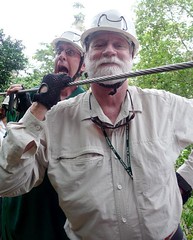 Actually the anniversary of the operation that saved by life went uncelebrated. I was among the treetops on the “survivor-like adventure course” at the Wacky Rollers Adventure Park near Roseau, Dominica. It did not occur to me that morning that twenty years earlier I was in Forsyth Memorial Hospital in Winston-Salem a few hours away from significant surgery. I have never written about that survivor-like adventure in detail. And as the Blog Police have given me a verbal warning about my lack of recent posts, here is the story - in three parts.
Actually the anniversary of the operation that saved by life went uncelebrated. I was among the treetops on the “survivor-like adventure course” at the Wacky Rollers Adventure Park near Roseau, Dominica. It did not occur to me that morning that twenty years earlier I was in Forsyth Memorial Hospital in Winston-Salem a few hours away from significant surgery. I have never written about that survivor-like adventure in detail. And as the Blog Police have given me a verbal warning about my lack of recent posts, here is the story - in three parts.Throughout 1988 I had been having headaches. Test after test, one specialists after another, and no cause could be found. It was not a sinus infection, not allergies. The headaches were not stress-related. Even a CAT scan showed nothing that would explain my headaches. The headaches were unpleasant, but not debilitating. I carried on. The pain would come and go, focused in my forehead and sinus area. But it was only that fall after my vision started to change, and my daughter noticed that my left pupil was larger than my right, that the pieces of the puzzle started to come together.
I made an appointment with my optometrist. He looked into my eyes and immediately - within an hour - had me examined by a buddy of his across town, an ophthalmologist. Conclusion: my eyes were fine. Whatever was causing my vision issues lay elsewhere. He contacted my GP, Dr. Deekens, who made an appointment in Winston-Salem with “the best neurologist he knew.” A week later the neurologist, Dr. Smith, listen to my story, asked a bunch of questions, told me, “I only do heads but I do them well,” and sent me down the street to a lab for an MRI. He said by the time I went home that night we were going to know what was causing my headaches. Confident, if a bit cocky. UVa. I liked that.
The MRI was cool. I was the last patient that day and after the images were taken the technician let me into the control room to watch the monitor as the equipment processed cross-sections of a brain, my brain. After a while he handed me a manilla envelope with the MRI film and I returned to the office of the neurologist. By this time it was dark, all his office staff had left. It was just me, him, and the film. We went to a light board; he hung the sheets at the top and switched on the light, just like on TV medical shows. Quiet for a couple of minutes, he then pointed out a small dark shadow behind my left eye. “A growth,” he said, “putting pressure on the optic nerve.” He allowed that it just did not show up as well on the CAT scan. I asked if another word for such a growth was cancer. He said, "Well, yes. But most growths in that area I have seen have been benign." He told me it probably needed to come out and he would make an appointment for me to see a neurosurgeon; they would let me know. It was a long drive home.
After Thanksgiving the neurosurgeon, Dr. Brown, saw me. After a quick evaluation he scheduled me to be admitted into the local hospital after the holidays, Tuesday, January 3, 1989. He said they would run some tests that day and the next day he would probably cut a small hole in the side of my head about the size of a silver dollar and removed the tumor. He advised that my left eye might be affected, that is I might not be able to use it for vision again. As if to reassure me, he said it was a very normal procedure, that he usually opened up two skulls each morning before lunch. I watched him write cancer on the admissions paperwork that required my signature. It all seemed unreal. He seemed a no-nonsense guy that Dr. Brown. I rather liked that too.
Christmas was subdued. The thought that I might lose the vision in one eye bothered me as much as anything. In my early 40’s, I still played basketball regularly. Having no depth perception could not help my jump shot. Golf could become even more a challenge as well. New Year's Day was warm enough so I hit the outdoor court for maybe the last time with two good eyes. I played with a mad intensity for over an hour, making damn sure I made my last few jump shots.
Monday, January 19, 2009
"These changes in latitudes, changes in attitudes;
nothing remains quite the same."
After the Fort Lauderdale round trip by car, an Airbus from FLL to Nassau, and 7,037 nautical miles of sea/river travel, we are back home, 34:57:1.84 North. First a bit wired and then just tired, I have been trying to catch up, clean up, and - with not much success - wrap my head around the last month. Jimmy Buffett has been helping with a soundtrack.
After the Fort Lauderdale round trip by car, an Airbus from FLL to Nassau, and 7,037 nautical miles of sea/river travel, we are back home, 34:57:1.84 North. First a bit wired and then just tired, I have been trying to catch up, clean up, and - with not much success - wrap my head around the last month. Jimmy Buffett has been helping with a soundtrack.
A month ago today the MV Explorer was not-so-gently wallowing towards St. Barts, encouraging the development of sea-legs, an appreciation of the differences in wave motion between the Atlantic Ocean and the Caribbean Sea, and nausea. Even though I had done my due diligence (appropriate clothing packed well, scoured the internet, and read a dozen or so books in preparation), that was one of many surprises; proving once again the value - the richness - of travel. Expectations just get in the way.
As this is a blog post, and I have not the time, skill, nor energy to write a travel narrative that does justice to those 21 days, here is a thumbnail version.
Semester-At-Sea. A 10 on a 10 point scale. These guys rock.  Making such an experience possible for students of all ages takes faith in the best of humanity, dedication, and balls. Time and time again I was struck by the professionalism, attention to detail, and loving care taken by the SAS/ISE staff. A wonderful idea well executed. The program has earned and deserves our admiration, love, and support ($$).
Making such an experience possible for students of all ages takes faith in the best of humanity, dedication, and balls. Time and time again I was struck by the professionalism, attention to detail, and loving care taken by the SAS/ISE staff. A wonderful idea well executed. The program has earned and deserves our admiration, love, and support ($$).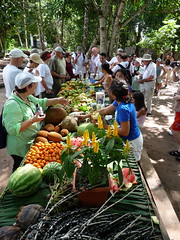 Fruit. I ate some of the most marvelous fruits. I cannot remember many of their names but the memories of flavor remain. I am very taken by the fruit of the acsi palm. Yes, it is being oversold - like most things - in the U.S. But it is wonderful, as is the fresh pineapple, bananas, passion fruit, mango, coconut, bread fruit, pomegranate, assorted oranges, limes, lemons and melons - the usual suspects - plus carambola, guava, sour sop, tamarind, and pawpaw. I really liked the sour sop. Freshness counts.
Fruit. I ate some of the most marvelous fruits. I cannot remember many of their names but the memories of flavor remain. I am very taken by the fruit of the acsi palm. Yes, it is being oversold - like most things - in the U.S. But it is wonderful, as is the fresh pineapple, bananas, passion fruit, mango, coconut, bread fruit, pomegranate, assorted oranges, limes, lemons and melons - the usual suspects - plus carambola, guava, sour sop, tamarind, and pawpaw. I really liked the sour sop. Freshness counts.
 Making such an experience possible for students of all ages takes faith in the best of humanity, dedication, and balls. Time and time again I was struck by the professionalism, attention to detail, and loving care taken by the SAS/ISE staff. A wonderful idea well executed. The program has earned and deserves our admiration, love, and support ($$).
Making such an experience possible for students of all ages takes faith in the best of humanity, dedication, and balls. Time and time again I was struck by the professionalism, attention to detail, and loving care taken by the SAS/ISE staff. A wonderful idea well executed. The program has earned and deserves our admiration, love, and support ($$).MV Explorer. One hell of a ship. Maybe a bit fancy for a floating campus; maybe my experiences on the Ryndam make me a bit jealous. Still, it feels like a ship rather than a floating hotel/barge. Fast too. Great crew. Home.
Enrichment Voyages. The Institute for Shipboard Education (ISE) sponsors these Enrichment Voyages between SAS semesters, a combination of some of the academic and educational experiences of a Semester-at-Sea with more conventional holiday cruise fare. While I would have preferred more SAS and fewer "fun cruise" oriented cranky old people who expected to have their buns kissed at every turn, ISE struck a good programatic balance on this voyage. The professors and local experts brought onboard to provide our lectures added greatly to my experience. I am especially in awe of Dan Everett. More Dan Everett, less bingo.
Americans On Holiday. Although many - maybe most - of my shipmates knew the difference between a voyage and a cruise, a ship and a boat, and were the full equivalent of my Fall '67 WCA shipmates (albeit much older), I still had opportunity to observe the sad antics and rudeness of Americans abroad. We will be much happier as a nation when we get over ourselves. I am not holding my breath. I wish a few of my shipmates had opted for Orlando for the holidays; we all would probably have been happier.
World Campus Afloat, Fall 1967. I tried, but I still cannot attempt to describe that experience without a lump in my throat, tears in my eyes.
Tourism. Many of the places we visited and individuals we met rely on tourism for a good portion of their livelihood. We appear at an appointed hour on our (generally) sanitized packaged tours, smile and take our photographs, ask the same predictable questions, and leave some money behind as we head to our next destination. Our hosts generally seem happy to see us arrive, sad to see us go. I wonder.
I wonder what we look like to them, how we sound. How would we feel having our communities toured, photos taken of our homes and families, our ways questioned, especially by people speaking a different language, with different skin colors, who obviously are orders of magnitude more wealthy.
At one stop a tour guide bet our group that we could not identify an object lying on the ground. He was shocked and flustered when several of us - including me - instantly recognized a yoke for oxen. "We are not as dumb as we look," one lady said, much to the amusement of all. "I certainly hope so," thought I. Now if we can only ratchet down the arrogance, self-righteousness, and ignorance.
As you can tell I have very mixed feelings about tourism, even well done. I hope it does more good than harm, for all concerned. I don't feel that way about travel. There is a difference.
The Amazon. Incomprehensible scale, richness. Christmas day about noon we were several hundred miles up river. 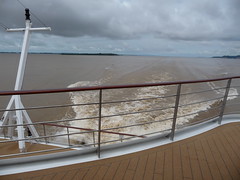 I was on the forward observation deck amazed at the width - maybe 3 miles at that point. As I was looking at the right riverbank the trees opened, revealing that the land was actually a narrow island, revealing another river channel about the same width. I was struck speechless. (Actually, prior to being speechless I uttered George Carlin words, a string of them.) Read a book or two about the river, watch National Geographic videos, go.
I was on the forward observation deck amazed at the width - maybe 3 miles at that point. As I was looking at the right riverbank the trees opened, revealing that the land was actually a narrow island, revealing another river channel about the same width. I was struck speechless. (Actually, prior to being speechless I uttered George Carlin words, a string of them.) Read a book or two about the river, watch National Geographic videos, go.
 I was on the forward observation deck amazed at the width - maybe 3 miles at that point. As I was looking at the right riverbank the trees opened, revealing that the land was actually a narrow island, revealing another river channel about the same width. I was struck speechless. (Actually, prior to being speechless I uttered George Carlin words, a string of them.) Read a book or two about the river, watch National Geographic videos, go.
I was on the forward observation deck amazed at the width - maybe 3 miles at that point. As I was looking at the right riverbank the trees opened, revealing that the land was actually a narrow island, revealing another river channel about the same width. I was struck speechless. (Actually, prior to being speechless I uttered George Carlin words, a string of them.) Read a book or two about the river, watch National Geographic videos, go.Brazil. Imagine the United States about 1880. The parallels are striking. Flush with natural resources, an energetic population, and eager to move beyond the sad consequences of colonialism, Brazil may well be beyond being perpetually the "Country of the Future" or the "Land of Unlimited Impossibilities." That said, I visited Brazil's equivalent of the Wild West, the states of Amazonas and Para, parts of the country few Brazilians have ever seen. If their politics can rise to match the strength of its people... yes, the parallels are striking.
Rubber, Sugar, Bananas. 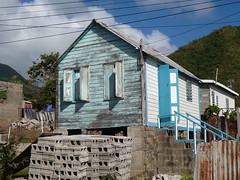 We in North America and Europe have little understanding of the true human and environmental costs of these "commodities," or how our industrial revolution was financed. We are just beginning to learn a bit about oil. The number of lives lived in misery and/or lost to put sugar in tea cups, tires on wheels, and fruit on our tables seems to have mattered little when the skin affected was mostly black or brown. Europeans transported hell to paradise, the results easily observed today throughout the Caribbean. And if one attempts to wishfully relegate this story to the past, consider the conversion of the relatively innocuous coca leaf to cocaine, and the misery to all concerned of that contribution of western chemistry. Just the tip of the Caribbean iceberg. And we wonder why some spit out the word colonialism with fear and hatred. Heads up folks, most of us are creoles, in one way or another.
We in North America and Europe have little understanding of the true human and environmental costs of these "commodities," or how our industrial revolution was financed. We are just beginning to learn a bit about oil. The number of lives lived in misery and/or lost to put sugar in tea cups, tires on wheels, and fruit on our tables seems to have mattered little when the skin affected was mostly black or brown. Europeans transported hell to paradise, the results easily observed today throughout the Caribbean. And if one attempts to wishfully relegate this story to the past, consider the conversion of the relatively innocuous coca leaf to cocaine, and the misery to all concerned of that contribution of western chemistry. Just the tip of the Caribbean iceberg. And we wonder why some spit out the word colonialism with fear and hatred. Heads up folks, most of us are creoles, in one way or another.
 We in North America and Europe have little understanding of the true human and environmental costs of these "commodities," or how our industrial revolution was financed. We are just beginning to learn a bit about oil. The number of lives lived in misery and/or lost to put sugar in tea cups, tires on wheels, and fruit on our tables seems to have mattered little when the skin affected was mostly black or brown. Europeans transported hell to paradise, the results easily observed today throughout the Caribbean. And if one attempts to wishfully relegate this story to the past, consider the conversion of the relatively innocuous coca leaf to cocaine, and the misery to all concerned of that contribution of western chemistry. Just the tip of the Caribbean iceberg. And we wonder why some spit out the word colonialism with fear and hatred. Heads up folks, most of us are creoles, in one way or another.
We in North America and Europe have little understanding of the true human and environmental costs of these "commodities," or how our industrial revolution was financed. We are just beginning to learn a bit about oil. The number of lives lived in misery and/or lost to put sugar in tea cups, tires on wheels, and fruit on our tables seems to have mattered little when the skin affected was mostly black or brown. Europeans transported hell to paradise, the results easily observed today throughout the Caribbean. And if one attempts to wishfully relegate this story to the past, consider the conversion of the relatively innocuous coca leaf to cocaine, and the misery to all concerned of that contribution of western chemistry. Just the tip of the Caribbean iceberg. And we wonder why some spit out the word colonialism with fear and hatred. Heads up folks, most of us are creoles, in one way or another.Things I Still Can Do, but Probably Shouldn't. Among the in-port activities I signed up for was a visit to the Wacky Rollers Adventure Park on Dominica and their "survivor-like" challenge course.  Yes, I did read the description before hand. But it kicked my butt. I did finish with only one minor slip, but I was exhausted. My companions kept asking me if I was alright. One said she thought I was going to die. I knew I was not, but that was little comfort. I need to either get in better aerobic shape, or become a spectator. I don't spectate well. And I bloody well earned that certificate.
Yes, I did read the description before hand. But it kicked my butt. I did finish with only one minor slip, but I was exhausted. My companions kept asking me if I was alright. One said she thought I was going to die. I knew I was not, but that was little comfort. I need to either get in better aerobic shape, or become a spectator. I don't spectate well. And I bloody well earned that certificate.
 Yes, I did read the description before hand. But it kicked my butt. I did finish with only one minor slip, but I was exhausted. My companions kept asking me if I was alright. One said she thought I was going to die. I knew I was not, but that was little comfort. I need to either get in better aerobic shape, or become a spectator. I don't spectate well. And I bloody well earned that certificate.
Yes, I did read the description before hand. But it kicked my butt. I did finish with only one minor slip, but I was exhausted. My companions kept asking me if I was alright. One said she thought I was going to die. I knew I was not, but that was little comfort. I need to either get in better aerobic shape, or become a spectator. I don't spectate well. And I bloody well earned that certificate.Native Americans. If you think the treatment of the locals by Europeans in North America since Columbus arrived was/is bad, study the history of Central and South America. 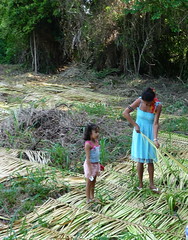 Hard to believe it could have been worse, but it was. Yes, things are better today, mainly because so few natives are left. We seem to revere Chico Mendes, but people still are being marginalized or killed, their land stolen, their forests burned. While today fewer Brazilians with native blood prepare bamboo to be used as roofing material, as our tour hosts are doing in this photo, many are still treated with contempt or neglect.
Hard to believe it could have been worse, but it was. Yes, things are better today, mainly because so few natives are left. We seem to revere Chico Mendes, but people still are being marginalized or killed, their land stolen, their forests burned. While today fewer Brazilians with native blood prepare bamboo to be used as roofing material, as our tour hosts are doing in this photo, many are still treated with contempt or neglect.
 Hard to believe it could have been worse, but it was. Yes, things are better today, mainly because so few natives are left. We seem to revere Chico Mendes, but people still are being marginalized or killed, their land stolen, their forests burned. While today fewer Brazilians with native blood prepare bamboo to be used as roofing material, as our tour hosts are doing in this photo, many are still treated with contempt or neglect.
Hard to believe it could have been worse, but it was. Yes, things are better today, mainly because so few natives are left. We seem to revere Chico Mendes, but people still are being marginalized or killed, their land stolen, their forests burned. While today fewer Brazilians with native blood prepare bamboo to be used as roofing material, as our tour hosts are doing in this photo, many are still treated with contempt or neglect.I Want To Go Back to ... St Kitts, followed closely by Dominica. Both were gorgeous and human scaled. In Brazil Manaus was a bit overwhelming, Santarem deserved more time. Barbados is also worth a second visit. Actually I would go back to them all.
Here is one reason I enjoyed St. Kitts, Greg's Tours.
 Fruit. I ate some of the most marvelous fruits. I cannot remember many of their names but the memories of flavor remain. I am very taken by the fruit of the acsi palm. Yes, it is being oversold - like most things - in the U.S. But it is wonderful, as is the fresh pineapple, bananas, passion fruit, mango, coconut, bread fruit, pomegranate, assorted oranges, limes, lemons and melons - the usual suspects - plus carambola, guava, sour sop, tamarind, and pawpaw. I really liked the sour sop. Freshness counts.
Fruit. I ate some of the most marvelous fruits. I cannot remember many of their names but the memories of flavor remain. I am very taken by the fruit of the acsi palm. Yes, it is being oversold - like most things - in the U.S. But it is wonderful, as is the fresh pineapple, bananas, passion fruit, mango, coconut, bread fruit, pomegranate, assorted oranges, limes, lemons and melons - the usual suspects - plus carambola, guava, sour sop, tamarind, and pawpaw. I really liked the sour sop. Freshness counts.Biggest Surprise. Trinidad. And I mean that in a good way. Diverse, an economy not dependent on tourism, large. It felt like a country, not an island. Yes, I had heard of Brian Lara before; no, I still do not understand cricket.
Biggest Disappointment. I wanted more time in each port.
Next Goal. Anita and I want to see a student from her university as part of the student body of SAS.
Wednesday, January 07, 2009
Homeward Bound
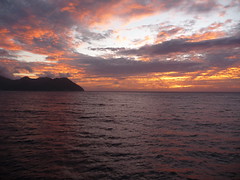 Today we are at sea, heading for port at Fort Lauderdale tomorrow morning. It is the first opportunity for R & R (rest and reflection) since 12/31 as we have been in one port or another for six days straight. I have been too busy, unable to gather my thoughts for blog postings. Your understanding is appreciated. Here is sunrise off Roseau, Dominica as compensation.
Today we are at sea, heading for port at Fort Lauderdale tomorrow morning. It is the first opportunity for R & R (rest and reflection) since 12/31 as we have been in one port or another for six days straight. I have been too busy, unable to gather my thoughts for blog postings. Your understanding is appreciated. Here is sunrise off Roseau, Dominica as compensation.The Caribbean is quiet and smooth this morning, the Explorer making rapid (~27 knots) pace. By this evening I expect most of what we brought aboard will be packed and we will have figured out what to do with all the stuff we bought. We might even have figured out our US customs paperwork.
Sometime next week I will probably post a blog or two about this voyage. Thoughts must be collected first. I did the best I could posting a few photos to Flickr; I hope they were sufficient for a thumbnail narrative of our past three weeks. Anita has done a better job on her blog.
The Amazon and Caribbean defy a few clever phrases, even mine. I will never be able to look at a teaspoon of sugar again without thinking of its cost in human lives over the years. I will not soon forget the exceptionally wonderful and professional Semester-at-Sea staff - and MV Explorer crew - who made this voyage possible. The blue waters, the marvelous tastes of local fruits, the resilience of the descendants of the slaves and indentured servants who live in the places we visited, all of these will be remembered.
Next hurricane season I will respond differently as the Weather Channel describes the paths and destruction of storms through places I have seen, harbors where I have slept.
It is a cliche that the world is getting smaller. It is also not true. We are getting larger, as individuals, as societies. Travel has always done that, electronic technology now has speeded up the process. The Amazon and the Caribbean are part of me now, and I am the larger and better for it.
Subscribe to:
Posts (Atom)
